
YOUR Contributions to the Philadelphia Institutions through the



YOUR Contributions to the Philadelphia Institutions through the

139 North Clark Street, Chicago 2, Ill.
or
48th and Spruce Streets Philadelphia 39 Penna.
GEORGE E. LETCHWORTH, Jr., Esq President. College and Hospital Boards.
DR. OTTERBEIN DRESSLER, Dean, Philadelphia College of Osteopathy.
OLIN L. EVANS, Superintendent, Osteopathic Hospital of Philadelphia.
PROF. KENNETH L. SENIOR. Department of Chemistry, Philadelphia College of Osteopathy.
MARGARET C. PEELER, Ph.B R.N.. Direc-.· tor. School of Nursing.
HELEN MILLER. R.N., Secretary, Nurses' Alumnae Association.
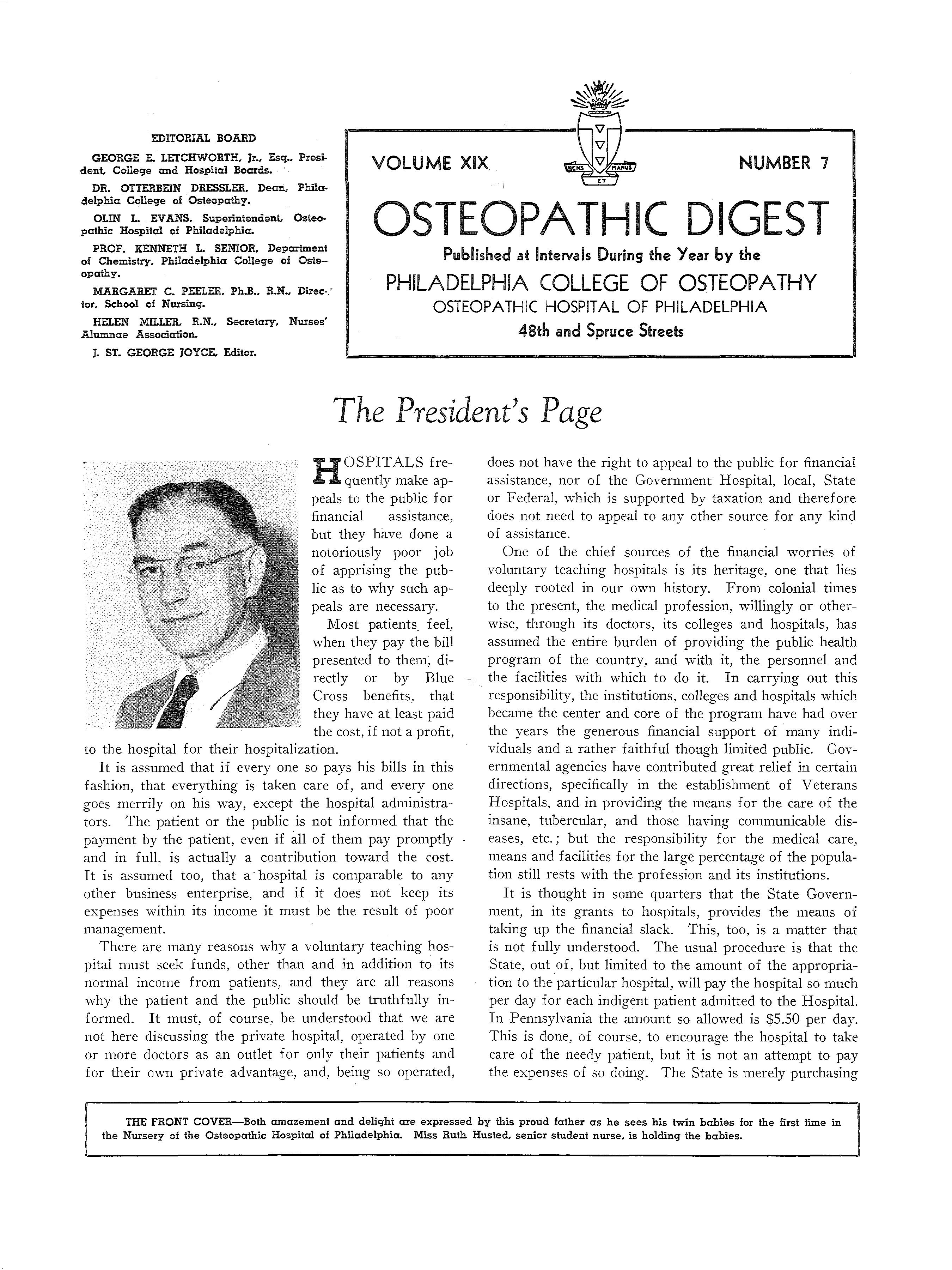
Published at Intervals During the Year by the
J. ST. GEORGE JOYCE. Editor. 48th and Spruce Streets
HOSPITALS frequently make appeals to the public for financial assistance, but they have done a notoriously poor job of apprising the public as to why such appeals are necessary.
Most patients_ feel, when they pay the bill presented to them, directly or by Blue Cross benefits, that they have at least paid the cost, if not a profit, to the hospital for their hospitalization.
It is assumed that if every one so pays his bills in this fashion, that everything is taken care of, and every one goes merrily on his way, except the hospital administra-tors. The patient or the public is not informed that the payment by the patient, even if all of them pay promptly and in full, is actually a contribution toward the cost. It is assumed too, that a hospital is comparable to any other business enterprise, and if it does not keep its expenses within its income it must be the result of poor management.
There are many reasons why a voluntary teaching hospital must seek funds, other than and in addition to its normal income from patients, and they are all reasons why the patient and the public should be truthfully informed. It must, of course, be understood that we are not here discussing the private hospital, operated by one or more doctors as an outlet for only their patients and for their own private advantage, and, being so operated,
does not have the right to appeal to the public for financial assistance, nor of the Government Hospital, local, State or Federal, vvhich is supported by taxation and therefore does not need to appeal to any other source for any kind of assistance.
One of the chief sources of the financial wornes of voluntary teaching hospitals is its heritage, one that lies deeply rooted in our own history. From colonial times to the present, the medical profession, willingly or otherwise, through its doctors, its colleges and hospitals, has assumed the entire burden of providing the public health program of the country, and with it, the personnel and the facilities with which to do it. In carrying out this responsibility, the institutions, colleges and hospitals vvhich became the center and core of the program have had over the years the generous financial support of many individuals and a rather faithful though limited public. Governmental agencies have contributed great relief in certain directions, specifically in the establishment of Veterans Hospitals, and in providing the means for the care of the insane, tubercular, and those having communicable diseases, etc.; but the responsibility for the medical care, means and facilities for the large percentage of the population still rests with the profession and its institutions.
It is thought in some quarters that the State Government, in its grants to hospitals, provides the means of taking up the financial slack. This, too, is a matter that is not fully understood. The usual procedure is that the State, out of, but limited to the amount of the appropriation to the particular hospital, will pay the hospital so much per day for each indigent patient admitted to the Hospital. In Pennsylvania the amount so allowed is $5.50 per day. This is done, of course, to encourage the hospital to take care of the needy patient, but it is not an attempt to pay the expenses of so doing. The State is merely purchasing
from the hospital at half price or less, a service which costs the hospital money, and which the State could not perform except at a much greater expense. The hospital, on the other hand, has a responsibility to the community it serves and therefore willingly endeavors to serve the community by taking care of the poor patient to the extent of its facilities.
Another phase of maintenance and operation of a hospital that greatly affects its economies is the constant and laudable desire of the profession to create and give to every patient, once he is a patient, the best care known to the profession. This policy produces through research, the many advances and discoveries known to the medical profession and enjoyed by the public today. This policy, hO\vever, is not an economic one. it is rather a scientific one, which does not mix too well \vith policies of economy and which does not always lend itself to the limitation of finance. If professionally something is lacking or needed for the care of a patient it must be made available, regardless of cost.
The hospital. in its care of the sick. turns out every clay, for the benefit of every patient, its entire personnel and all its equipment from heating plant to flovvers, for the care, cure and comfort of all of them and their families, and in performing this service the dominating factor is to give the patient the best service possible, with little concern as to whether the patient is poor or rich. The mere matter of handling flowers .sent to patients costs the hospitals many hundreds of dollars a year. It is not only a custom, but the custom is one that is for the good of the patient, and therefore the hospital provides the service.
The difficulty in balancing in the hospital budget is a matter that is both misunderstood and a source of criticism, chiefly because of the erroneous conclusion that since it is clone in industry it can be clone by hospitals. The simple truth is that the operation and maintenance of a voluntary teaching hospital is not a business or an industry in the accepted sense. Such hospitals are different.
A private enterprise, business or industry, will establish its price to include both the cost and a profit to the owner. and if a profit is not the net result, the enterprise will be discontinued. Private business seeks its customers wholly with regard to their ability to pay. and wholly
without regard to the customers' actual need, to the extent that, however great the need, there is no sale if he cannot pay. To the hospital, on the other hand, the element of profit is nonexistent. The high cost. of its plant, equipment and services, is such that there is no formula by which it can be spread, and because it is so far in excess of the ability of most patients, the rates charged in many instances are but token charges in so far as they relate to the costs. There is a feeling among many that overhead costs and capital expenditures should not be included in the fommla in establishing rates or in deter mining costs.
Unlike the business man, th.e hospital cannot seek its customer, but when they do come the dominating factor is the patient's need for its service rather than the hospital's desire or need for revenue, and this is true to the extent that the service is rendered even though the patient cannot pay.
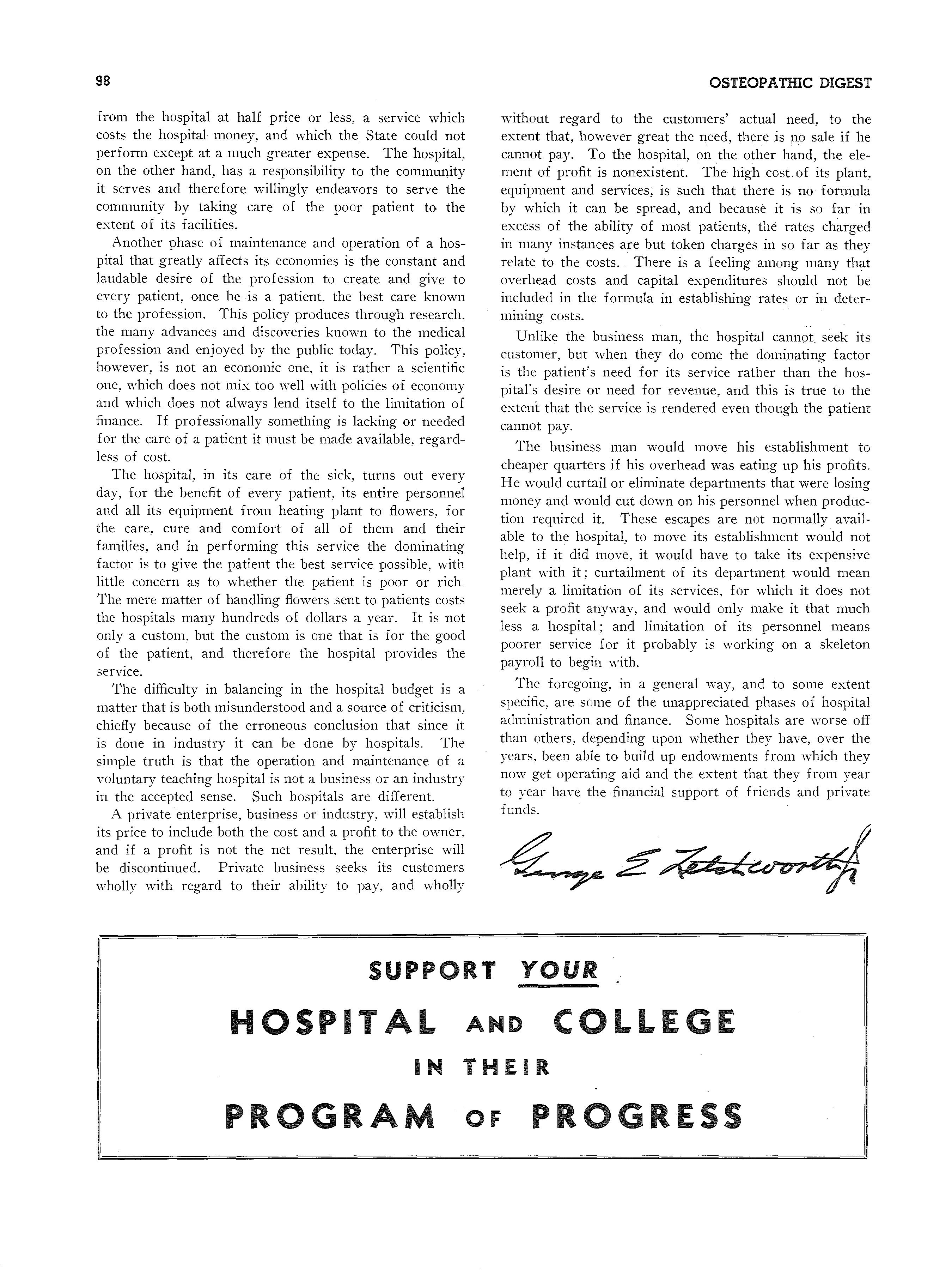
The business man would move his establishment to cheaper quarters if his overhead was eating up his profits. He would curtail or eliminate departments that were losing money and would cut down on his personnel when production required it. These escapes are not nonnally available to the hospital. to move its establishment would not help, if it did move, it would have to take its expensive plant with it: curtailment of its department ·would mean merely a limitation of its services, for which it does not seek a profit anyway, and would only make it that much less a hospital; and limitation of its personnel means poorer service for it probably is working on a skeleton payroll to begin vvith.
The foregoing, in a general way, and to some extent specific, are some of the unappreciated phases of hospital administration and finance. Some hospitals are worse off than others, depending upon whether they have, over the years, been able to build up endowments from which they now get operating aiel and tbe extent that they from year to year haYe the, financial support of friends and private funds.
ISTORICALLY the Osteopathic Hospital of Philadelp:1ia was chartered under the laws of Pennsylvania, May 10, 1911, "to establish, support and conduct a general hospital for the treatment of sick and injured persons, and to conduct a Trainillg School for Nurses." The corporation has no stock, and by law must not be conducted for profit. The Hospital was the outgrowth of a Dispensary, located at 1617 Fairmount Avenue. In 1911 the Osteopathic Hospital of Philadelphia was established at 410 South
9th Street. When the college moved to 19th and Spring Garden Streets, the Hospital was temporarily quartered at 1725 Spring Garden Street, where it remained until completion of the hospital building on the 19th Street site in 1918.
In January, 1929, the governing bodies of the College and Hospital sponsored a public campaign for funds settinga goal of $1,030,000, to meet the needs for a "Temple of Learning and Healing," a new College and Hospital building. The site on the northeast comer of 48th and Spruce Streets was purchased in 1928 at a cost of $165,000.00 This tract has a frontage of 281 feet on Spruce Street and 250 feet on 48th Street. As a result of the public drive for funds the present building was erected and additional nurses' homes acquired.
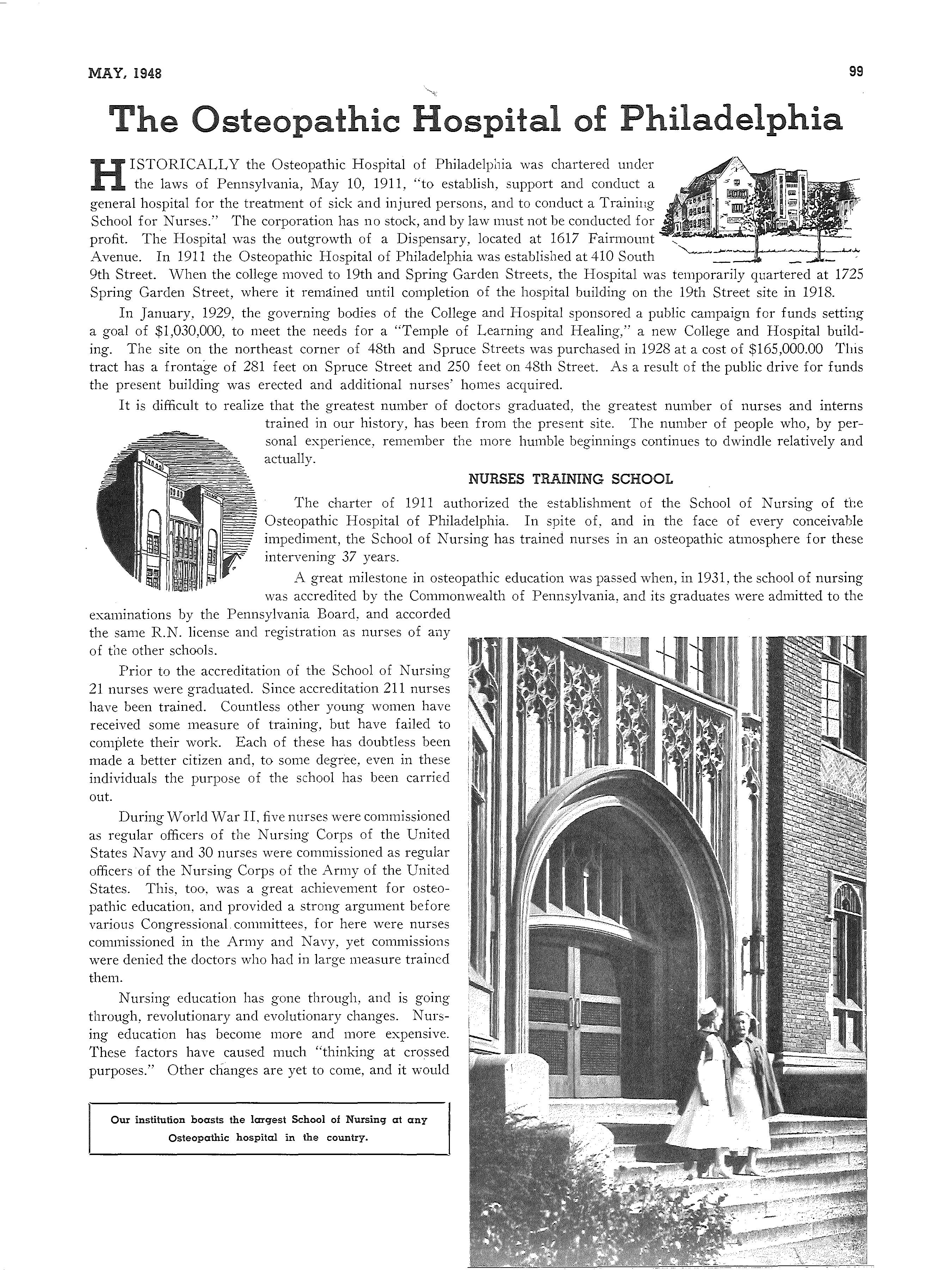
It is difficult to realize that the greatest number of doctors graduated, the greatest number of nurses and interns trained in our history, has been from the present site. The number of people who, by personal experience, remember the more humble beginnings continues to dwindle relatively and actually.
The charter of 1911 authorized the establishment of the School of Nursing of tbe Osteopathic Hospital of Philadelphia. In spite oL and in the face of every conceivable impediment, the School of Nursing has trained nurses in an osteopathic atmosphere for these intervening 37 years.
A great milestone in osteopathic education was passed when, in 1931, the school of nursing was accredited by the Commonwealth of Pennsylvania, and its graduates were admitted to the examinations by the Pennsylvania Board, and accorded the same R.N. license and registration as nurses of any of the other schools.
Prior to the accreditation of the School of Nursing 21 nurses were graduated. Since accreditation 211 nurses have been trained. Countless other young women have received some measure of training, but have failed to complete their work. Each of these has doubtless been made a better citizen and, to some degree, even in these individuals the purpose of the school has been carried out.
During World 'vVar II, five nurses were commissioned as regular officers of the Nursing Corps of the United States Navy and 30 nurses were commissioned as regular officers of the Nursing Corps of the Army of the United States. This, too. was a great achievement for osteopathic education. and provided a strong argument before various Congressional committees, for here were nurses commissioned in the Army and Navy, yet commissions were denied the doctors who had in large measure trained them.
Nursing education has gone through, and is going through, revolutionary and evolutionary changes. N ursing education has become more and more expensive. These factors have caused much "thinking at crossed purposes." Other changes are yet to come, and it would
Our institution boasts the largest School of Nursing at any Osteopathic hospital in the country.
seem imperative that we retain this foothold in the field of nursing for osteopathic education. Because of its great public relations value it is not too much to be hoped for that support from the Osteopathic Profession may be secured to help subsidize our School of Nursing.
During the fiscal year 1946-47, 6,927 patients entered the hospital for 51,668 patient days of care. This has brought a large segment of our populace from all walks of life through our doors. It is amazing to :see how Osteopathic Medicine has touched and influenced the lives of the poorest of our people, as well as the more fortunate classes. Only a few years ago it was felt that osteopathic medicine could serve only the well to do. Time has spread its benefits to all classes.
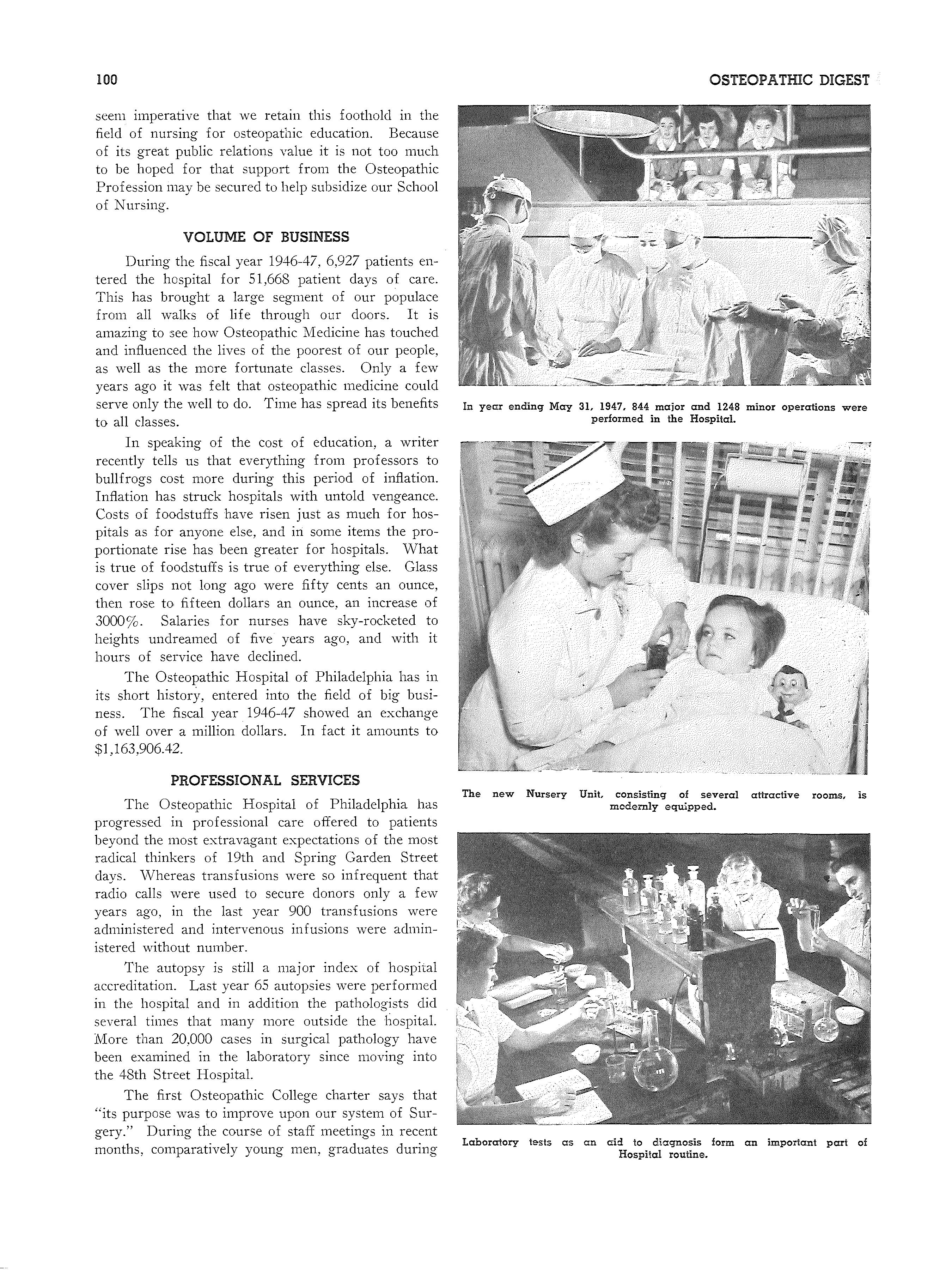
In speaking of the cost of education, a writer recently tells us that everything from professors to bullfrogs cost more during this period of inflation. Inflation has struck hospitals with untold vengeance. Costs of foodstuffs have risen just as much for hospitals as for anyone else, and in some items the proportionate rise has been greater for hospitals. What is true of foodstuffs is true of everything else. Glass cover slips not long ago were fifty cents an ounce, then rose to fifteen dollars an ounce, an increase of 3000%. Salaries for nurses have sky-rocketed to heights undreamed of five years ago, and with it hours of service have declined.
The Osteopathic Hospital of Philadelphia has in its short history, entered into the field of big business. The fiscal year 1946-47 showed an exchange of well over a million dollars. In fact it amounts to $1 ,163,906.42.
The Osteopathic Hospital of Philadelphia has progressed in professional care offered to patients beyond the most extravagant expectations of the most radical thinkers of 19th and Spring Garden Street clays. \i\Thereas transfusions were so infrequent that radio calls were used to secure donors only a few years ago, in the last year 900 transfusions were administered and intervenous infusions were administered without number.
The autopsy is still a major index of hospital accreditation. Last year 65 autopsies were performed in the hospital and in addition the pathologists did several times that many more outside the liospital. More than 20,000 cases in surgical pathology have been examined in the laboratory since moving into the 48th Street Hospital.
The first Osteopathic College charter says that "its purpose was to improve upon our system of Surgery." During the course of staff meetings in recent months, comparatively young men, graduates during
Osteopathic Hospital's most publicized patient-six-yearold Kathleen Walsh, of West Grove, N.J., who, after spending two years in the Hospital a helpless cripple since birth because of b-laleral congenital dislocation of hip joints, walked out of the institution after three operations by Dr. James M. Eaton •
the 48th Street era, have reported upon operations, the like of
Garden Street little dreamed. The operations in point of boldness,
other criterions, have marked tremendous advances in the practice
in the intervening years. Particularly noteworthy are the advances in orthopedic surgery and gastro-intestinal surgery.
In the fiscal year 1946-47, there were 1,179 births of which 630 were males, 549 females. In addition several hundred babies were delivered outside the hospital on clinic service. Again this year, the first baby born in 1948 was in the Osteopathic Hospital of Philadelphia, so far as metropolitan Philadelphia is concerned.
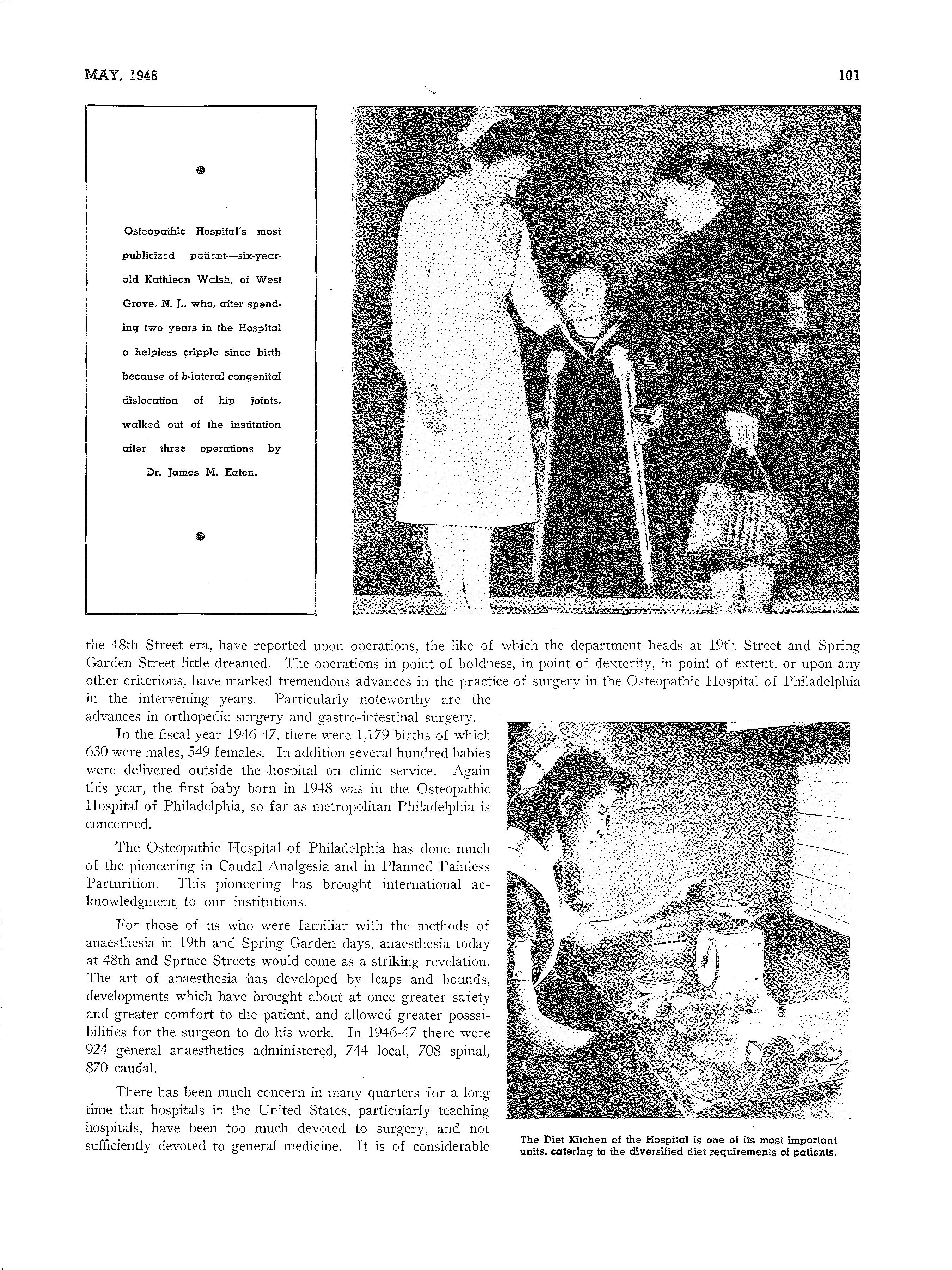
The Osteopathic Hospital of Philadelphia has clone much of the pioneering in Caudal Analgesia and in Planned Painless Parturition. This pioneering has brought international CJ.Cknowledgment to our institutions.
For those of us who were familiar with the methods of anaesthesia in 19th and Spring Garden days, anaesthesia today at 48th and Spruce Streets would come as a striking revelation. The art of anaesthesia has developed by leaps and bounds, developments which have brought about at once greater safety and greater comfort to the patient, and allowed greater posssibilities for the surgeon to do his work. In 1946-47 there were 924 general anaesthetics administered, 744 local, 708 spinal, 870 caudal.
There has been much concern in many quarters for a long time that hospitals in the United States, particularly teaching hospitals, have been too much devoted to surgery, and not sufficiently devoted to general medicine. It is of considerable
interest to observe, that in the Osteopathic Hospital of Philadelphia there has been a continuous development of Osteopathic Medicine, with more cases of a general nature coming to the hospital, and a greater interest in the medical side of the surgical case. Pediatrics has shown substantial growth. Previously in these pages there has been reported, new facilities and re-arrangement of space to accommodate greater numbers of pediatric cases.
In the various inspections by the Army and the Navy, much emphasis was made in reporting upon manipulation in the treatment of patients in our hospital and in our out-patient department. Recent inspections by the American Osteopathic Association made a point of the emphasis upon manipulation in our hospital. A full time instructor is employed to teach and oversee students as they administer this form of therapy in our hospital.
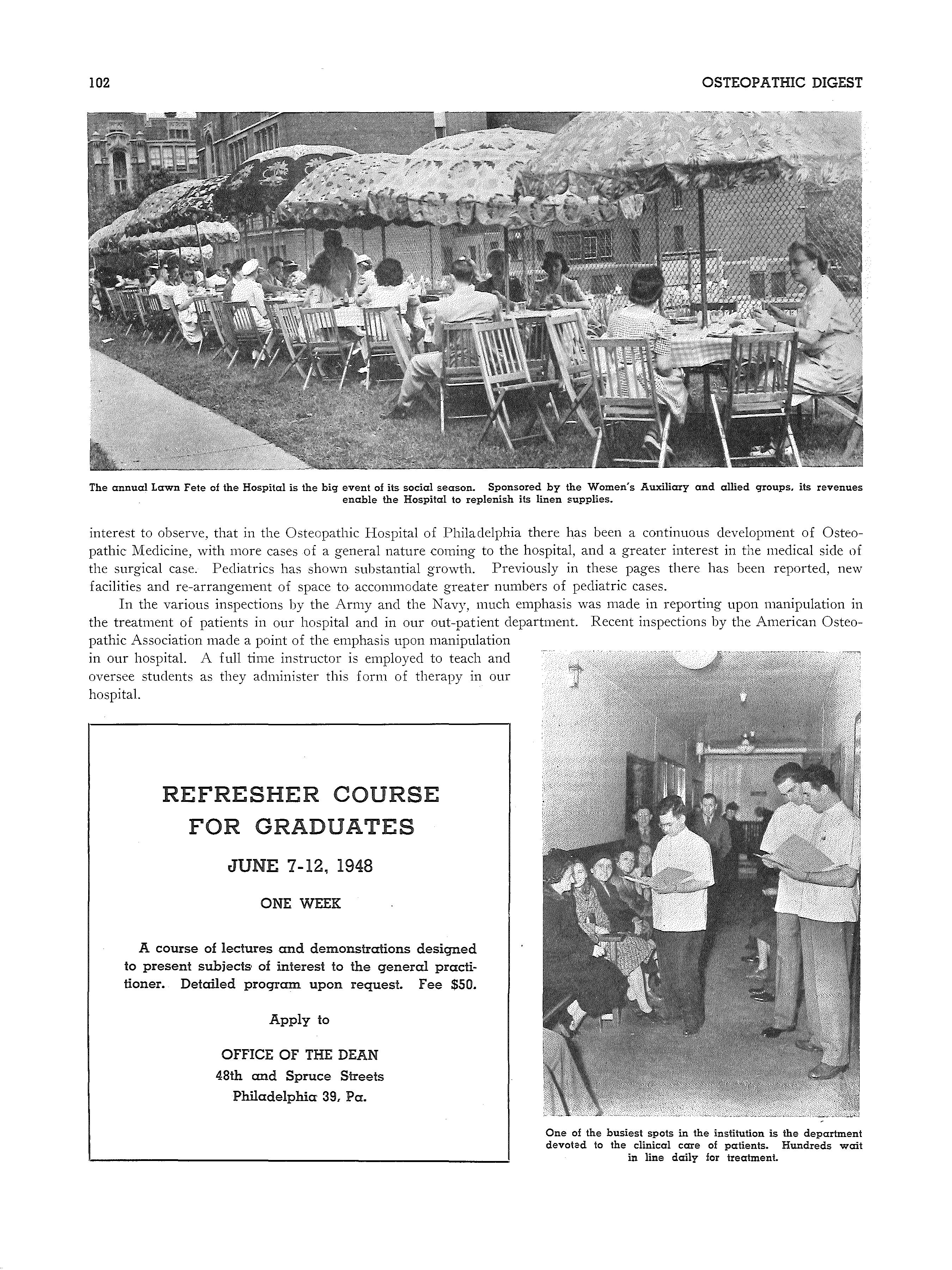
In 1947, 1179 babies were born in the Hospital. In this picture are sisters who became mothers simultaneously, thus making newspaper headlines • Student interns manipulating patients under direction of their instructor, Dr. Barbara Redding •
The new Chemistry Laboratory is a valuable acquisition. The picture shows Prof. Senior a! work.
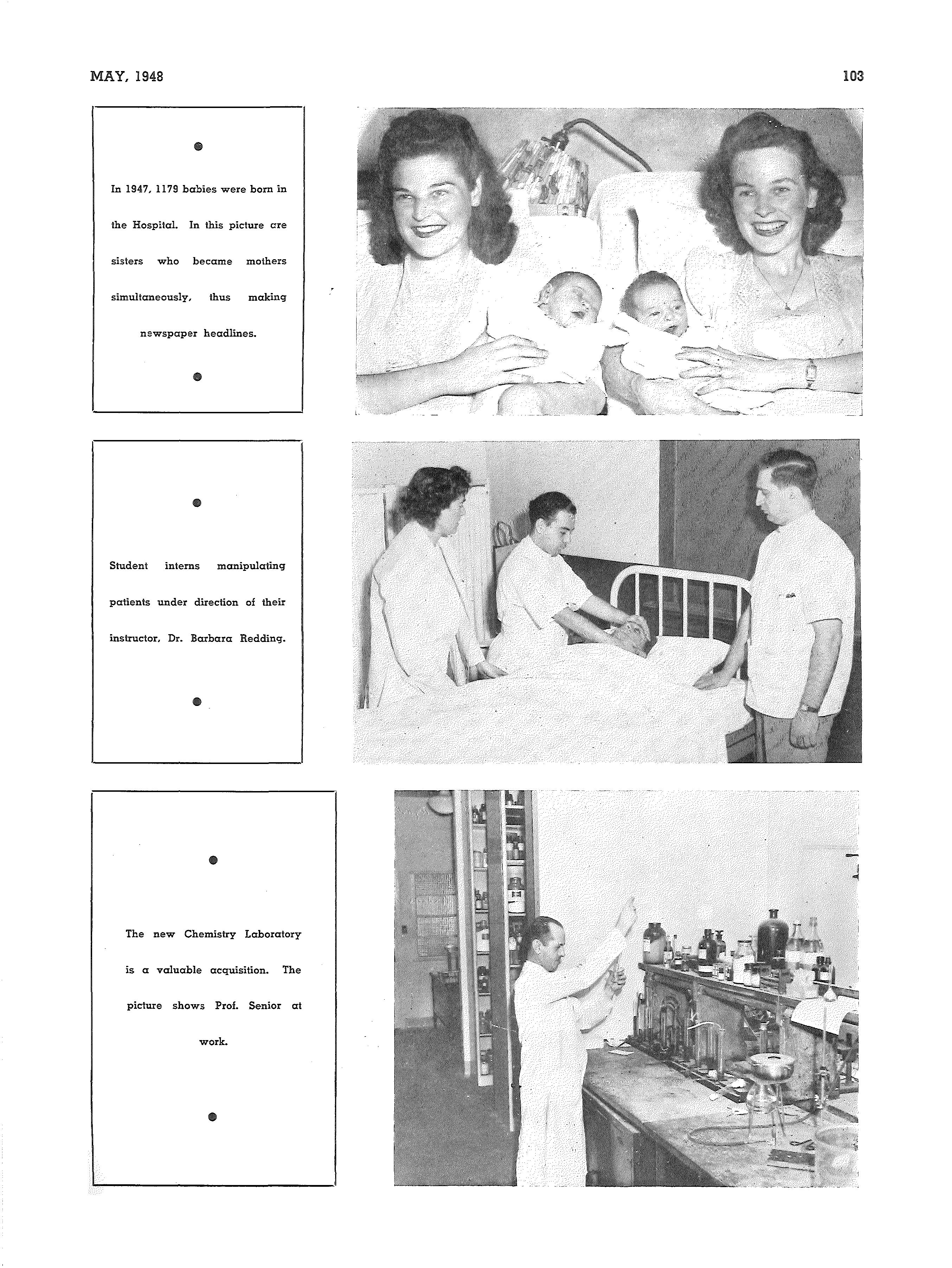
which it is now costing annually to carry on this work.
Officers for last year were : Mrs. Henry ]. Claus-President Mrs. \JVilliam Boal-1st Vice President Mrs. Henry J. Claus-2nd Vice President Mrs. Edmori E. Van Horn-Treasurer Miss Ethel K. Bell-Assistant Treasurer Mrs. S. Sterling Smith-Recording Secretary
Mrs. H. \IV alter Evans-Corresponding Secretary
\!Vhy can't you as students' wives form an organization to help the hospital? This was the question asked by Mrs. Raymond Bailey, Women's Auxiliary president, back in 1931. So with that thought in mind the Junior Aid was formed, Mrs. Arthur Flack Jr., being elected the first president. '
Most of the young women were interested in babies and the maternity floor, so it was decided to raise funds for the purchase of linens for the nursery.
As the Junior Aid's activities grew, through card parties, a booth at the Lawn Fete, rummage sales, luncheons and dances,· they were able to expand their aid to the entire maternity floor and purchase, not only linens, but also bottle warmers, oxygen tent, heating pads and sterilizer, totaling over $1200.
HEADS OF WOMEN'S ORGANIZATIONS AT OSTEOPATHIC HOSPITAL Pictured above are the presidents of the three leading women's groups at the hospital. They are, left to right, Mrs. George Court, president. Junior Aid; Mrs. Henry J. Claus, newlyelected president of the Women's Auxiliary; and Mrs. Annette Albeck, president, Camden County Osteopathic Auxiliary. Prevented by illness from posing in !his picture was Mrs. G. C. Frantz, retiring president of the Women's Auxiliary, whose place in the picture was taken by the incoming president, Mrs. Henry J. Claus. To Mrs. Frantz well-merited recognition is due for faithful service.
In reviewing the growth, development and accomplishments of the Osteopathic Hospital, full recognition must be given the tireless efforts of the women's organizations so closely identified with the institution's forward progress. TheEe groups are the Osteopathic Hospital \Nomen's Auxiliary, the Junior Aid, the Camden County Women's Osteopathic Association, and the Students' Wives' Club, the members of which groups have given unstintingly of their time and energies to make our hospital the outstanding institution of healing it is today. On behalf of the Hospital the DrGEST salutes these loyal bands of courageous women.
The Women's Auxiliary of the Osteopathic Hospital of Philadelphia was organized February 19, 1919, by Dr. Simon Peter Ross. It comprised doctors' wives, patients, and friends of Osteopathy in general. Its purpose was to raise funds to buy a nurses' home. In time, this was done and the home equipped. From that time on, the Auxiliary has devoted itself to the purchasing and supplying of the linens for the hospital and its nurses' homes, now numbering three. \JVhen funds permitted, however, extra necessary equipment for the hospital was purchased.
Each Monday morning a group of about twenty or twenty-five women meet on the fourth floor of the hospital and cut, sew, stamp, and fill requisitions for linens for the ensuing week. There are about fifteen
electric sewing machines in use, two of which were the gracious gift recently of the Junior Aid. Mrs. Edgar D. Doyle, as Chairman of the Sewing Committee, has given nearly seventeen years of efficient, faithful, and tireless service in this capacity, beside doing all the purchasing of the linens.
Funds with which to carry on this work are largely raised through the lawn fete each Spring, two. large card parties and bazaars each year, and the dues of the members, ranging from $1.00 for active membership, $5.00 for contributing, and $100.00 for life membership. To Mrs. Edward ]. Albert (whose inimitable charm is known throughout the hospital), Chairman of the Ways and Means Committee for the past fourteen years, and Mrs. Doyle, who has run the lawn fete for the same number of years goes the credit for successfully raising the $3,500.00 or more
Prcgress over the past 17 years has expanded its help to the Children's Ward and the purchase of many much needed items at the hospital. An Orthopedic Table at the cost of $500 is one such item.
Approximately $1300 is spent annually by the Junior Aid to help keep our hospital in new equipment and better our facilities for the care of the ill.
A few years ago the organization called Students' ViTives united with the Junior Aid.
Our present officers are: Mrs. George Court, president; Mrs. James Eaton, recording secretary; Mrs. John Molinari, treasurer; Mrs. H. W. Sterrett, Jr., correspondmg secretary.
The Camden County Osteopathic Auxiliary was organized in January, 1940. In the beginning, the main object of attention was the nurses' home of the Hospital. After a few years help was needed for the Hospital itself and these women have furnished five rooms in the past five years. At this point, they are looking forward with renewed vitality toward even greater gains for one of the finest Hospitals in Philadelphia-The Osteopathic Hospital.
Officers are as follo-.,Ns: President-Mrs. Annette Albeck; Vice President and Corresponding Secretary-Mrs. Marie Standring; Recording Secretary-Mrs. Katherine ·Mitchell; Treasurer-Mrs. Beverly Graff; Wavs and Means Chairman-Mrs. Florence Hospital Chairman-Mrs. Marie Standring; Publicity Chairman-Mrs. Robina Irvine; Membership Chairman-Mrs. Charlotte Flack: Librarian-Mrs. Flarence Lyon.
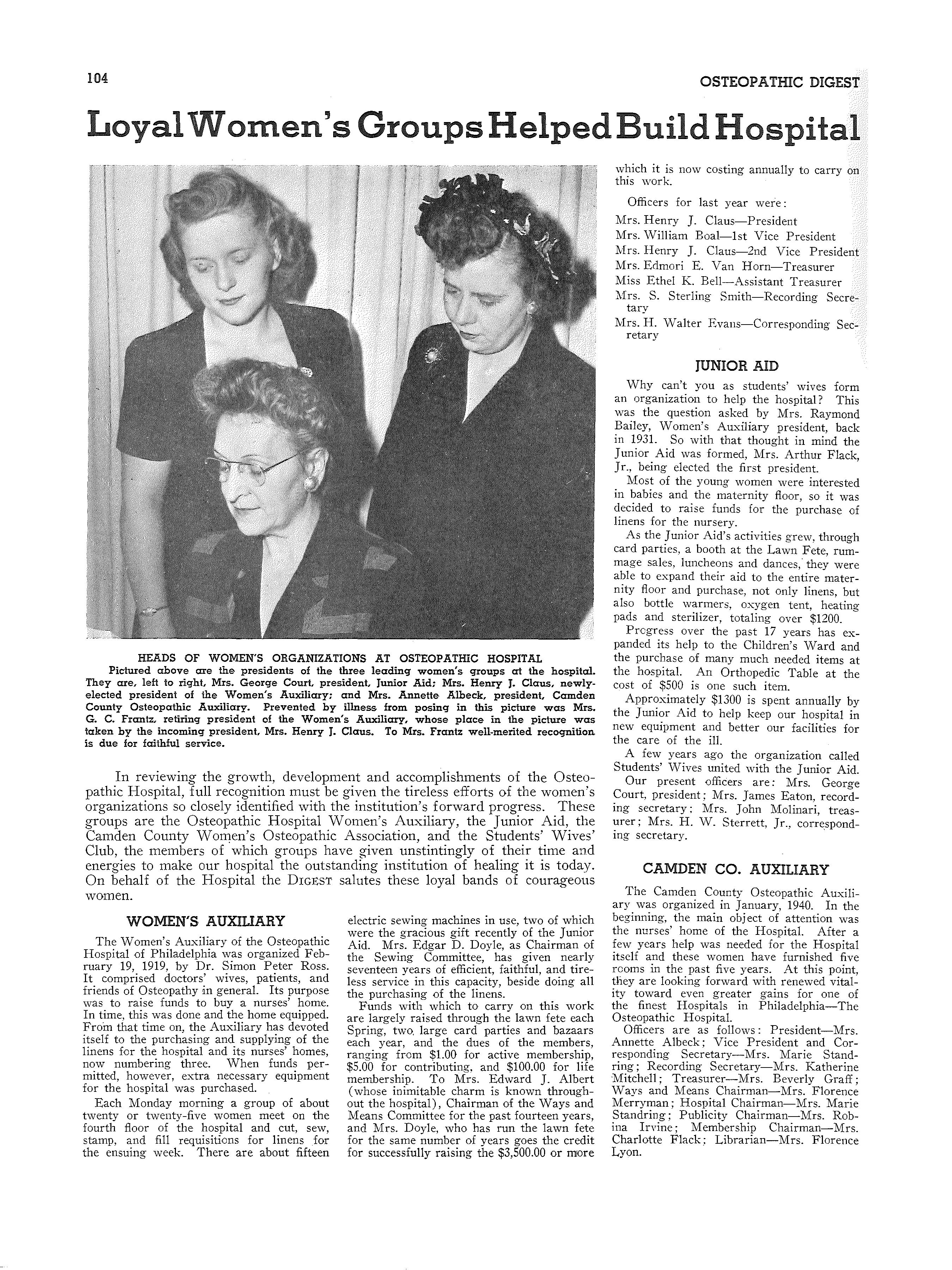
Announcement was made recently of basic courses in Surgery, to be presented in units from time to time. The first unit was to be surgical pathology, the second surgical anatomy, the third surgical diagnosis, the fourth surgical technique, and a fifth portion is being planned to comprehend chemistry, physiology, pharmacology, and toxicology, with time devoted to medical jurisprudence. It is believed that by the time a surgeon has pursued these basic courses, he will find that he has acquired a wealth of useful information.
Pedagogically, the process of learning is not a continuous one, but if graphed, would be a series of steps, rather than a diagonal line. This principle has been seized upon by offering these courses first one day a week. Such a policy also is to the advantage of those who live within commuting distance of Philaclel phia. Pedagogically, economically, and, indeed, in all points, this plan is the most desirable.
At a later elate it is hoped to present similar courses in an intensive fashion for shorter periods of time for those who live further away from Philadelphia. The first course, the one in surgical pathology, began March 13, 1948. On the first clay each student was supplied with the required text for ti1e course, Boyd's Surgical Pathology, each was supplied with a syllabus of the course, and a lecture note outline to aid him in his work A sample autopsy protocol was provided to guide the student in the preparation of his own protocols.
On the first day of the course, three autopsies were performed, with one of the students serving as an assistant. Follow up information that could not be provided at the time of autopsy has since been given to these students to more fully complete the picture. On this first day also, a lecture hour was provided, followed by a two hour laboratory period on the basic subject of the day, which in this particular session was. "The Problem of Inflammation." Succeeding upon the laboratory period of two hours, a session on fresh surgical pathology and fresh autopsy materials with round table discussions was provided.
This course will continue for a period of sixteen weeks. By limiting the class to a small number, a most unusual opportunity has been provided for graduate teaching. The contact of one student with the other and with the instructors is far closer than we could
DR. FRANK GLENN LANKARD.
Dean of Brothers College of University, Madison, N. J., will deliver the address at commencement ceremonies of the Philadelphia College of Osteopathy, to be held on June 5 in Irvine Auditorium.
Frank Glenn Lankard, educator, clergyman a n d author, was born in the State of Kansas and received his early education there. He attended the University of Kansas, Baker University, Boston University, Garrett Biblical Institute, and Northwestern University, from which he holds the doctorDr. Frank Glenn ate. He was Lankard granted the honorary degree, LL.D.,
from Baker University.
Dr. Lankard served churches in New Hampshire and Illinois. He .has been professor of Biblical Literature in the University of Chattanooga, Northwestern University and Drew UniYersity. He has been dean of Brothers College of Drew University for the past seventeen years.
Dean Lankard is a member of many learned societies and has been active in civic work In the year 1942-1943 he was Governor of the 182nd District of Rotary International, and was a member of the 1945-1946 Youth Committee of Rotary International. In 1946 he was appointed observer for Rotary International to the Third Session of the Economic and Social Council of the United Nations. Dean Lankard has been chairman of the Board of Directors of the Morris County YMCA since 1944.
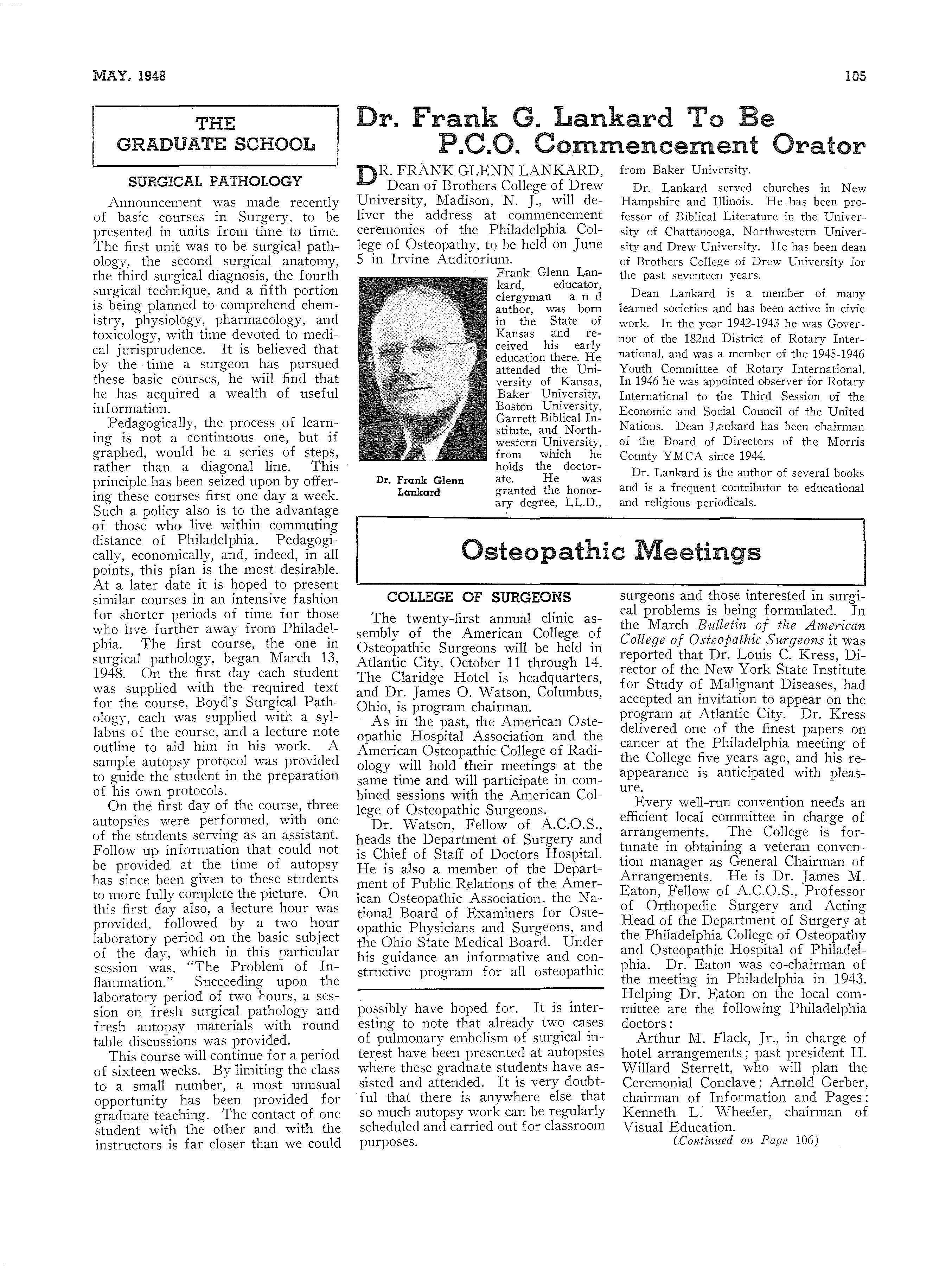
Dr. Lankard is the author of several books and is a frequent contributor to educational and religious periodicals.
The twenty-first annual clinic assembly of the American College of Osteopathic Surgeons will be held in Atlantic City, October 11 through 14. The Claridge Hotel is headquarters, and Dr. James 0. Watson, Columbus, Ohio, is program chairman.
As in the past, the American Osteopathic Hospital Association and the American Osteopathic College of Radiology will hold their meetings at the same time and will participate in combined sessions with the American College of Osteopathic Surgeons.
Dr. Watson, Fellow of AC.O.S., heads the Department of Surgery and is Chief of Staff of Doctors Hospital. He is also a member of the Department of Public Relations of the American Osteopathic Association. the National Board of Examiners for Osteopathic Physicians and Surgeons. and the Ohio State Medical Board. Under his guidance an informative and constructive program for all osteopathic
possibly have hoped for. It is interesting to note that already two cases of pulmonary embolism of surgical interest have been presented at autopsies where these graduate students have assisted and attended. It is very doubtful that there is anywhere else that so much autopsy work can be regularly scheduled and carried out for classroom purposes.
surgeons and those interested in suro·ical problems is being formulated. In the March Bulletin of the College of Osteopathic Surgeons it was reported that Dr. Louis C. Kress, Director of the New York State Institute for Study of Malignant Diseases, had accepted an invitation to appear on the program at Atlantic City. Dr. Kress delivered one of the finest papers on cancer at the Philadelphia meeting of the College five years ago, and his reappearance is anticipated with pleasure.
Every well-run convention needs an efficient local committee in charge of arrangements. The College is fortunate in obtaining a veteran convention manager as General Chairman of Arrangements. He is Dr. James M. Eaton. Fellow of AC.O.S Professor of Surgery and Acting Head of the Department of Surgery at the Philadelphia College of Osteopathy and Osteopathic Hospital of Philadelphia. Dr. Eaton was co-chairman of the meeting in Philadelphia in 1943. Helping Dr. Eaton on the local committee are the following Philadelphia doctors:
Arthur M. Flack, Jr., in charge of hotel arrangements; past president H. Willard Sterrett, who will plan the Ceremonial Conclave: Arnold Gerber. chairman of Information and Pages; Kenneth L. Wheeler, chairman of Visual Education.
(Continued on Page 106)
Elsewhere in this publication, an announcement of Three Courses for Graduates, under the Philadelphia College of Osteopathy, appears. For many years, this college offered short, intensive review courses to provide a refresher for the conscientious general practitioner. These were well received by the profession, one of them had an enrollment of more than 100 graduates, who came here from many states. Many years ago, the college faculty learned that the profession was hungry for continuing study. Its intellectual appetite has never been entirely satisfied.
Instruction on a graduate level, however, is of a different type than that which is projected to the undergraduate, and it is, indeed, the unusual teacher who is competent at both levels. The multiplicity of developments and advances in the healing arts during the last twenty-five years has been amazing. Likewise, the changing philosophy of medical education which now demands small group instruction and emphasis upon. the basic sciences, has made it incumbent upon the alert professor to take time, each year, for personal courses.
Realizing that the usual intensive two week review course is no longer adequate for the needs of the graduate, the Philadelphia College now offers a longer course in Osteopathic Medicine. It will be of four weeks' duration, extending from June 7, 1948, through July 2, 1948. Not every one on the undergraduate faculty is qualified, by experience and training, to formulate and fulfill the syllabus of the many ramifications of this field of practice.
At the annual Spring Luncheon and meeting of the Women's Auxiliary of the Osteopathic Hospital of Philadelphia, held on April 12 at the Adelphia Hotel, Mrs. Henry J. Claus was elected president of the organization.
Other officers elected were :
First Vice- President, Mrs. William Boa!; Second Vice-President, Mrs. Anna Housenick; Recording Secretary, Mrs. Sterling S. Smith; Corresponding Secretary, Mrs. H. VValter Evans; Treasurer, Mrs. Edmori E. Van Horn; and Assistant Treasurer, Mrs. Ethel K. Bell.
An afternoon of cards followed the meeting, of which Mrs. Edward J. Albert was chairman. Mrs. G. C. Frantz retired as president after four vears of active and efficient service. " Principal speaker was George E. Letchworth. Jr., Esq president of the Board of Directors of the Hospital.
Hence, it has been necessary to supplement the regular faculty with other well known authorities from within and outside the osteopathic profession.
In conformity with modern methods in medical education. the basic sciences will be stressed as they are integrated with the practical phases of each subject considered. The college library will be open to those who desire to correlate the lecture material and slides, with text book study.
The courses in cardiology, through July into August, are designed for those interested in securing special instruction in this field. The enrollment in these classes will be limited to the number that can be supervised adequately in a clinical course. The courses in cardiology have been planned as basic requirements for the later, more advanced, and more extensive courses, now in preparation for the select few who wish to specialize at a future time.
The sudden and increasing demand for training residencies in the specialties has compelled consideration of attendance in a graduate school which is basic to a residency. Opportunity for residents in osteopathic medicine who require academic work to supplement their hospital services, will be available in the Three Courses for Graduates being offered during the months of June and July 1948.
Official bodies and the profession have been pressing the college for postgraduate courses. This summer, the Philadelphia College of Osteovathy is answering some of these demands. Its efforts are worthy of support!
Announcement is made that Dr. C. Haddon Soden, for many years, Professor of Osteopathic Therapeutics, and now Emeritus Professor of Osteopathic Therapeutics, in the Philadelphia College of Osteopathy, has been invited to give a series of lectures in London, England, May 25th to June 6th, inclusive, 1948.
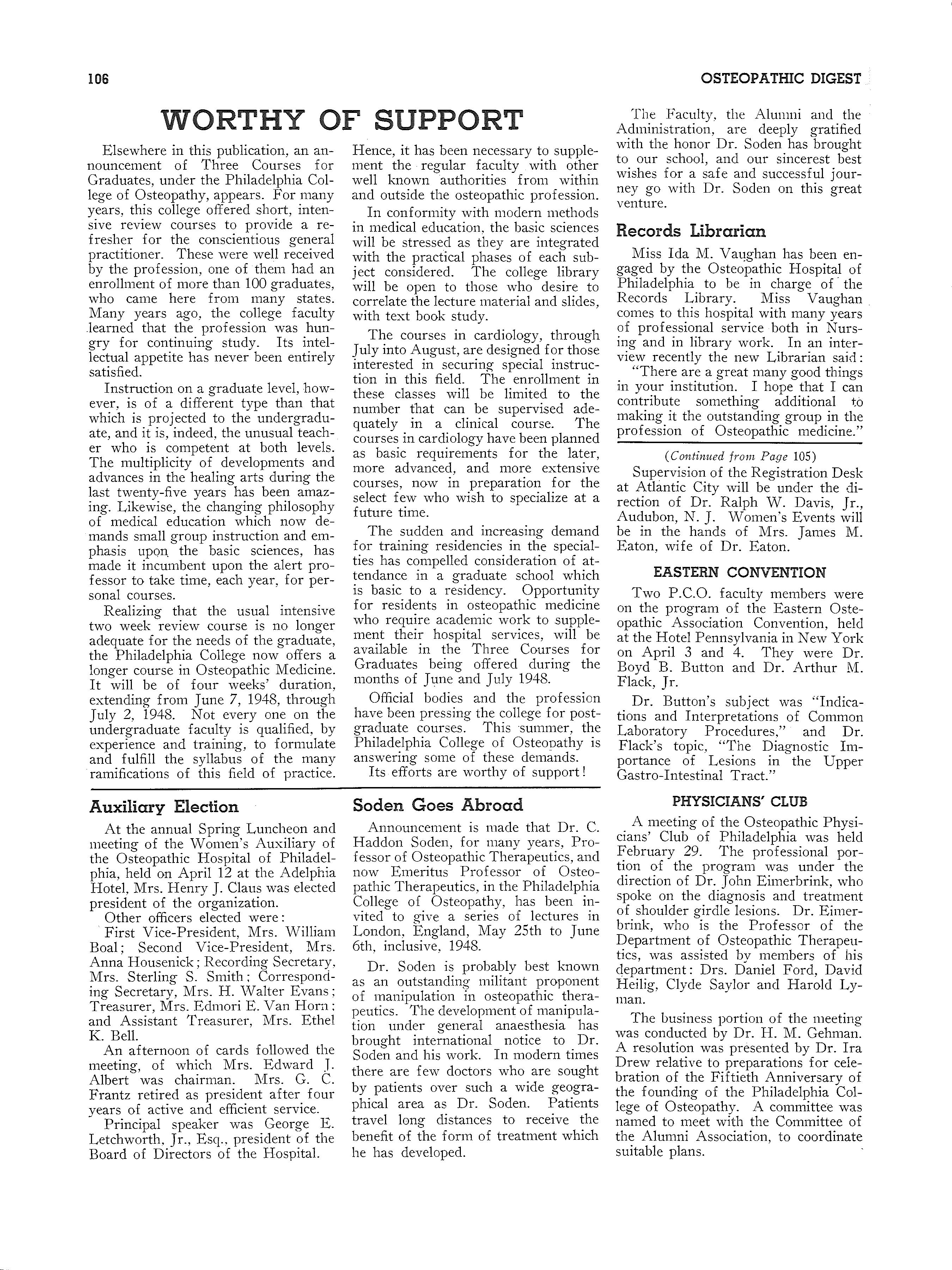
Dr. Soden is probably best known as an outstanding militant proponent of manipulation in osteopathic therapeutics. The development of manipulation under general anaesthesia has brought international notice to Dr. Soden and his work. In modern times there are few doctors who are sought by patients over such a wide geographical area as Dr. Soden. Patients travel long distances to receive the benefit of the form of treatment which he has developed.
The Faculty, the Alumni and the Administration, are deeply gratified with the honor Dr. Soden has brought to our school, and our sincerest best wishes for a safe and successful journey go with Dr. Soden on this great venture.
Miss Ida M. has been engaged by the Osteopathic Hospital of Philadelphia to be in charge of· the Records Library. Miss Vaughan comes to this hospital with many years of professional service both in Nursing and in library work. In an interview recently the new Librarian said : "There are a great many good things in your institution. I hope that I can contribute something additional to making it the outstanding group in the profession of Osteopathic medicine."
(Continued from Page 105)
Supervision of the Registration Desk at Atlantic City will be under the direction of Dr. Ralph W. Davis, Jr., Audubon, N.J. Women's Events will be in the hands of Mrs. James M. Eaton, wife of Dr. Eaton.
Two P.C.O. faculty members were on the program of the Eastern Osteopathic Association Convention, held at the Hotel Pennsylvania in New York on April 3 and 4. They were Dr. Boyd B. Button and Dr. Arthur M. Flack, Jr.
Dr. Button's subject was "Indications and Interpretations of Common Laboratory Procedures," and Dr. Flack's topic, "The Diagnostic Importance of Lesions in the Upper Gastro-Intestinal Tract."
A meeting of the Osteopathic Physicians' Club of Philadelphia was held February 29. The professional portion of the program was under the direction of Dr. John Eimerbrink, who spoke on the diagnosis and treatment of shoulder girdle lesions. Dr. Eimerbrink, who is the Professor of the Department of Osteopathic Therapeutics, was assisted bv members of his department: Drs. Daniel Ford, David Heilig, Clyde Saylor and Harold Lyman.
The business portion of the meeting was conducted by Dr. H. M. Gehman. A resolution was presented by Dr. Ira Drew relative to preparations for celebration of the Fiftieth Anniversary of the founding of the Philadelphia College of Osteopathy. A committee was named to meet with the Committee of the Alumni Association, to coordinate suitable plans.
NOW that the first semester is but a memory, and the reality of a nevv term is all around us, the planne.d activities of a very enthusiastic group have again taken a back seat for the forthcoming examinations. There is a very slight hope that through this veil of confusion may emerge a class banquet or a dance before the end of the term.
During the Christmas holidays and the big "bogie man" period of examinations, several freshmen took the last mile to the altar to say, "I do." During the same period of time, several others made curtain calls with blessed events.
Those who took the marital vows were Bernard Abramson and N annan Queler. The stork paid calls on the happy households of Mr. and Mrs. Marvin L. Mitnick, and Mr. and Mrs. Arthur L Feldman. We, their classmates, have reserved this small space to wish for all of them very happy and prosperous lives.
Mrs. Lovelace underwent an operation, and the news from the front is, she is at home and well on the way to recovery. We are all glad, Jack.
Rumors are that wedding bells will be ringing very soon for Carl J. \Vesley and Robert S. Weldon. There should be a couple of parties? ? ?
The new representatives to Student Council were given their first taste of high finance at a special meeting called for the purpose of supporting our school paper "Axone." It would save a lot of wear and tear on the aspirin bottle if there was a little more support from the Alumni and the Student Body to keep this paper going.
LAWSON PAL:YIER Chairman, Freshman ClassThe members of Student Council have busied themselves, for the past several months, discussing plans whereby the student paper, "The Axone," may continue publication. To say the least, the financial intake has been most discouraging, while on the other side of the ledger, the financial output has been tremendous. The Student Council, to date, has paid out $227.20 toward the support of our school paper. This is a rather grave situation since vve must ask ourselves, "how long can we continue to publish our school paper, which requires over $700.00 a year, while our annual intake from the student body is approximately $250.00 ?''
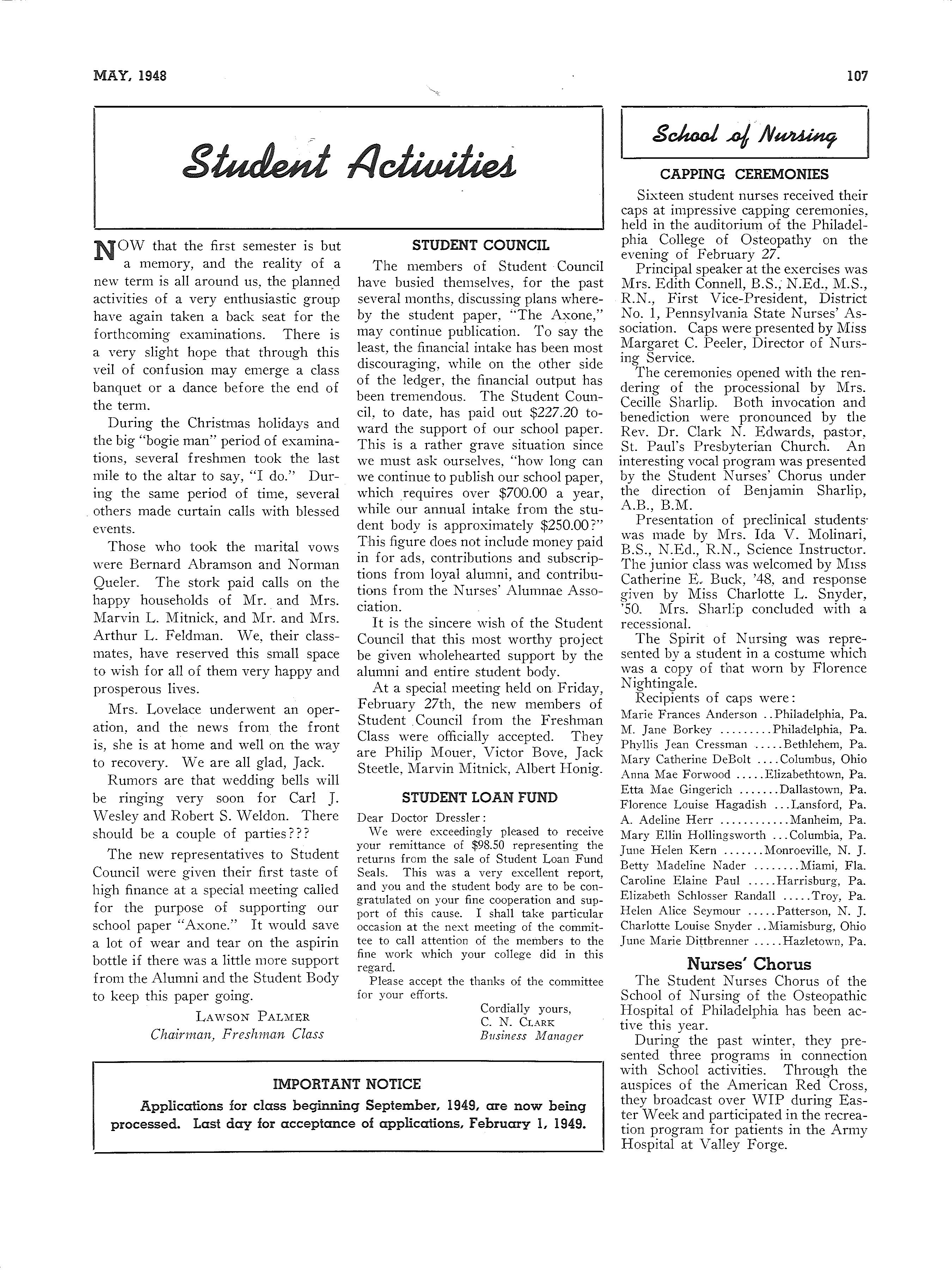
This figure does not include money paid in for ads, contributions and subscriptions from loyal alumni, and contributions from the Nurses' Alumnae Association.
It is the sincere wish of the Student Council that this most worthy project be given wholehearted support by the alumni and entire student body.
At a special meeting held on Friday, February 27th, the new members of Student Council from the Freshman Class were officially accepted. They are Philip Mauer, Victor Bove, Jack Steetle, Marvin Mitnick, Albert Honig.
Dear Doctor Dressler : \Ve were exceedingly pleased to receive your remittance of $98.50 representing the returns from the sale of Student Loan Fund Seals. This was a very excellent report, and you and the student body are to be congratulated on your fine cooperation and support of this cause. I shall take particular occasion at the next meeting of the committee to call attention of the members to the fine work which your college did in this regard.
Please accept the thanks of the committee for your efforts.
Cordially yours, c. N. CLARK Business Manager
Sixteen student nurses received their caps at impressive capping ceremonies, held in the auditorium of the Philadelphia College of Osteopathy on the evening of February 27.
Principal speaker at the exercises was Mrs. Edith Connell, B.S., N.Ed., M.S., R.N., First Vice-President, District No. 1, Pennsylvania State Nurses' Association. Caps were presented by Miss Margaret C. Peeler, Director of Nursing Service.
The ceremonies opened with the rendering of the processional by Mrs. Cecille Sharlip. Both invocation and benediction were pronounced by the Rev. Dr. Clark N. Edwards, pastJr, St. Paul's Presbyterian Church. An interesting vocal program was presented by the Student Nurses' Chorus under the direction of Benjamin Sharlip, A.B., B.M.
Presentation of preclinical students· vvas made by Mrs. Ida V. Molinari, B.S., N.Ed., R.N., Science Instructor. The junior class was welcomed by M1ss Catherine E. Buck, '48, and response given by Miss Charlotte L. Snyder, 'SO. Mrs. SharEp concluded with a recessional.
The Spirit of Nursing was represented bv a student in a costume which was a copy of tbat worn by Florence Nightingale.
Recipients of caps were:
Marie Frances Anderson Philadelphia, Fa. M. Jane Borkey Philadelphia, Fa. Phyllis Jean Cressman Bethlehem, Fa. J\Iary Catherine DeBolt Columbus, Ohio Anna Mae Forwood Elizabethtown, Fa. Etta Mae Gingerich Dallastown, Fa. Florence Louise Hagadish Lansford, Fa. A. Adeline Herr Manheim, Fa. Mary Ellin Hollingsworth Columbia, Fa. June Helen Kern Monroeville, N. J. Betty Madeline Nader Miami, Fla. Caroline Elaine Paul Harrisburg, Fa. Elizabeth Schlosser Randall Troy, Fa. Helen Alice Seymour Patterson, N. ]. Charlotte Louise Snyder Miamisburg, Ohio June Marie Dittbrenner Hazletown, Fa.
The Student Nurses Chorus of the School of Nursing of the Osteopathic Hospital of Philadelphia has been active this year.
Applications for class beginning September, 1949, are now being processed. Last day for acceptance of applications, February L 1949.
During the past winter, they presented three programs in connection with School activities. Through the auspices of the American Red Cross, they broadcast over WIP during Easter Week and participated in the recreation program for patients in the Army Hospital at Valley Forge.
ANNA E. BRANDT of Conshohocken, Pennsylvania, died January 27, 1948. She is reported to have been ill one week.
IVAN BIXBY has been a patient in the Wills Eye Hospital in Philadelphia.
DR. J. L. SIKORSKI, P.C.O., '31, C.O.O.P.S., '32, has been appointed a fee designated physician in the Veterans' Administration.
FRANK DeMALFY has been seriously ill for some time.
DR. JOHN A. SZYMANSKI has been appointed a fee designated physician in the Veterans' Administration.
After April 1, the office of Dr. F. C. SINAGRA will be located at 1616 Pacific Avenue, Atlantic City, N. ].-Professional Arts Building, Suite SOL Dr. Sinagra was formerly located at 1925 Pacific Avenue.
CHARLES BAILEY FLACK has announced the opening of his office for practice at 80 Elm St., Waterville, Maine.
J. EDWARD VINN announces his marriage November 29, 1947. Following a year of internship at Spark's Hospital in Dallas, he practiced in Velasco, and now in Houston, Texas. He is affiliated with the Houston Osteopathic Hospital.
EDWARD D. WHITE, after long service in the Army, has served an internship with the Allentown Osteopathic Hospital, and has now opened an office at 1103 Walnut St., Allentown, Penna.
S. V. ORIGLIO has contributed a review, "Conditions Indicating Thoracic Surgery," making up Volume II, Number 9, of the Clinical Notes of the Lamb Memorial Hospital, Denver, Colorado.
HAROLD KIRSH has announced the opening of his office at 435 Marlton Pike, Erlton, New Jersey.
BEN SCHREIBER announces the opening of an office for the practice of Osteopathy at 25 E. 86th St., New York, 28, New York.
MAX LAWRENCE KAMEN, D.O., LI.B., announces the opening of an office as consultant to the medical and legal professions in problems involving medico-legal jurisprudence at 662 Eastern Parkway, Brooklyn, New York.
DANIEL FINKELSTEIN has completed his internship at the Osteopathic Hospital of Chicago has opened an office for the general practice of Osteopathy at 1425 Townsend Ave., Bronx 52, New York.
WILBUT W. BALDWIN has completed his internship at the Osteopathic Hospital of Philadelphia and has opened an office for the practice of Osteopathic Medicine and Obstetrics at 5004 Ross Ave., Dallas. Texas.
EDITOR'S NOTE-This is the twelfth of a series of thumb-nail sketches of P.C.O. alumni who are·carryinq the torch of-Osteopathy and for the Philadelphia Colleqe--men and women out in the field whose everyday have no glamorous side, but whose devotion and fidelity to duty make them a credit lo their profession and lo the colleqe they represent.
THE son of our late distinguished Founder has been cited by the Editorial Board of the DIGEST as the outstanding alumnus of the Philadelphia College of Osteopathy for this issue of the DIGEST. He is Dr. Joseph C. Snyder, widely-known, currently-practicing Philadelphia
Osteopathic physician, who served his country conspicuously in the Navy in the last war, and who has been closely identified with progressive movements for the advancement of the Osteopathic therapy.
The DIGEST salutes Dr. Snyder, who, "like father, like son," is· definitely a "chip off the old block," having inherited characteristics which made the name of 0. J. Snyder a synonym of greatness in the field of Osteopathic education.
Dr. Joseph C. Snyder's umque record of service follows:
Born April 2, 1907, at Narberth, Penna. Father-0. J. Snyder, M.S., D.O., D.Sc., ( Ost).
Mother-Aline C. Snyder. One younger brother and sister. 1924-Enlisted in U. S. Navy. 1926-Entered U. S. Naval Academy. 1930-Graduated U. S. Naval Academy. 1930-40-Active in U. S. Naval Reserve, Philadelphia Battalion.
1932-Entered Philadelphia College of Osteopathy. Osteopathy, Atlas Club; Neo Society.
1936-40-General practice in Philadelphia and associated with Philadelphia Colleo-e of Osteopathy in teaching and clinical capacity. Active in State and County pathic Associations.
1940-Called to active duty in U. S. Navy. , ,_ 1940-47-In Navy, serving as Assistant Naval Attache in London, as special observer at Chungking, China, and as Commanding Officer of six naval vessels. Duty included American, European and Pacific Theaters of operations. December 1946 released to inactive duty with rank of Commander. ' '
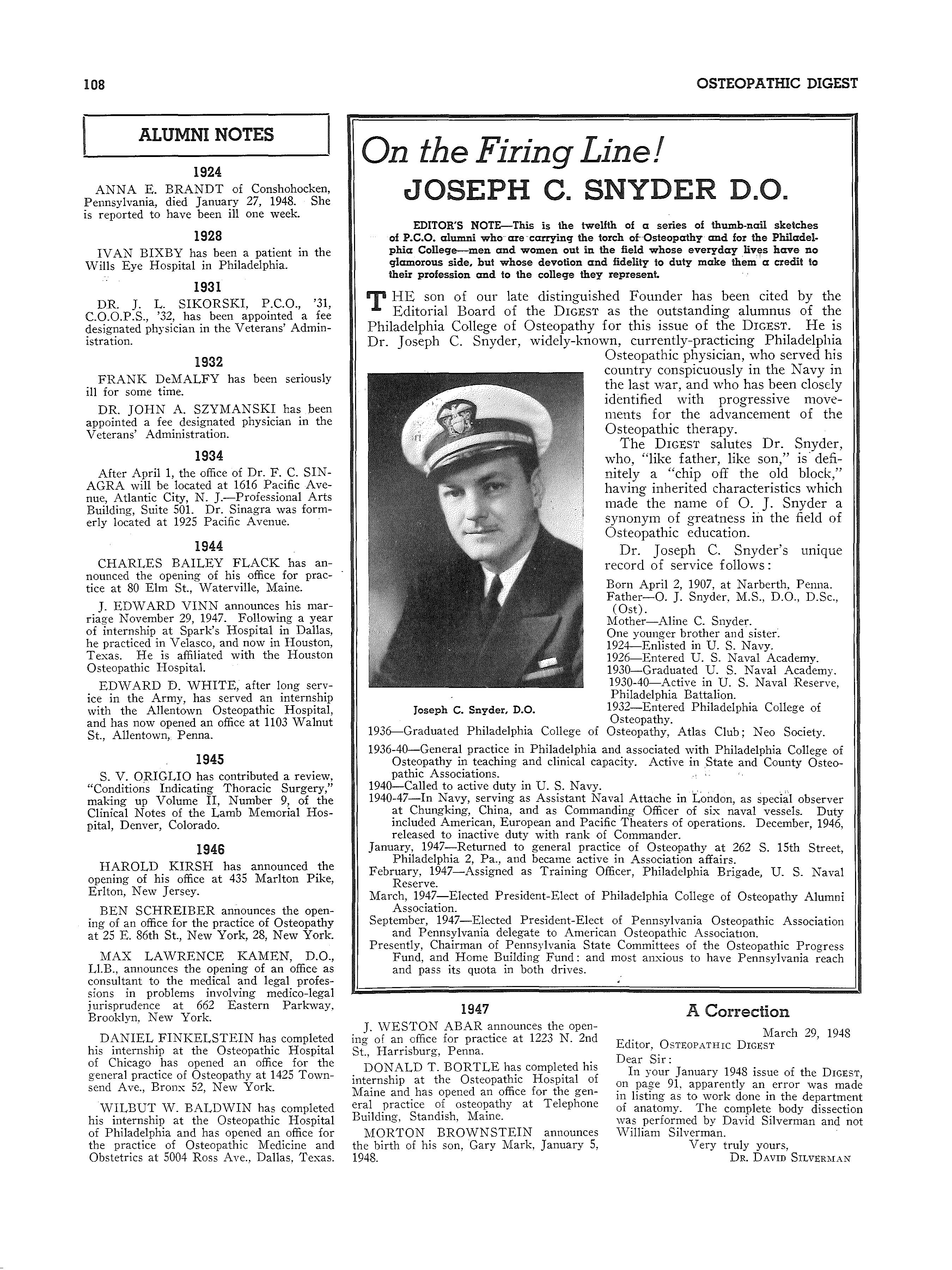
January, 1947-Returned to general practice of Osteopathy at 262 S. 15th Street, Philadelphia 2, Pa., and became active in Association affairs.
February, 1947-Assigned as Training Officer, Philadelphia Brigade, U. S. Naval Reserve.
March, 1947-Elected President-Elect of Philadelphia College of Osteopathy Alumni Association.
September, 1947-Elected President-Elect of Pennsylvania Osteopathic Association and Pennsylvania delegate to American Osteopathic AssociatiOn.
Presently, Chairman of State Committees of the Osteopathic Progress Fund, and Home Bmldwg Fund: and most anxious to have Pennsylvania reach and pass its quota in both drives.
J. vVESTON ABAR announces the opening of an office for practice at 1223 N. 2nd St., Harrisburg, Penna.
DONALD T. BORTLE has completed his internship at the Osteopathic Hospital of Maine and has opened an office for the general practice of osteopathy at Telephone Building, Standish, Maine.
MORTON BROWNSTEIN announces the birth of his son, Gary Mark, January 5, 1948.
March 29, 1948
Editor, OsTEOPATHIC DIGEST
Dear Sir:
In your January 1948 issue of the DIGEST, on page 91. apparently an error was made in listing as to work done in the department of anatomy. The complete body dissection was performed by David Silverman and not vYilliam Silverman.
Very truly yours, DR. DAVID SILVERMAN
OSTEOPATHIC MEDICINE (PARTS L II, IIL IV) June 7 to July 2, 1948
Part !-Diseases of Nutrition, Metaborsm, Internal Secretion June 7, 1947, through June 1L 1948
$200.00 75.00
Part II-Diseases of Kidney and Liver. Psychosomatic Medicine. Arthritis. Cancer . 75.00 June 14, 1948, through June 18, 1948
Part III-Diseases of Blood forming Organs. Allergy. Diabetes. Infectious Diseases (exclusive of the exanthemata) 75.00 June 2L 1948, through June 25, 1948
Part IV-Diseases of the Heart including Arteriosclerosis. Peripheral Vascular Disease. Diseases of the Lung 75.00 June 28, 1948 through July 2, 1948
THIS course \Yill emphasize the current trends in Osteopathic Medicine, at a graduate level. It will he given as a refresher for specialists and as a re,·iew for candidates preparing for examination before the A.merican Board of Osteopathic Internists. general practitioners can use the instruction as an admirable refresher course covering the recent developments in the fields listed. This course will also sen·e as an excellent introduction to the later, more searching, advanced courses for specialty training, now in preparation.
CARDIOLOGY (fundamentals) July 5, 1948, through July 16, 1948 $150.00
This course has been devised for the busy general practitioner vvho desires instruction in Cardiology. It will provide an excellent foundation for the physician who aims to specialize in this field. Emphasis \ov·ill be placed upon the clinicaL laboratory, and radiographic diagnosis and the treatment of the commoner heart diseases and hypertension. The basic principles of electrocardiography and kymography will be covered. Instruction will be planned in a way that the material given be appropriate as an introduction to more advanced courses in Cardiovascular Diseases, Cardiology, Pediatric Cardiology, etc. Cardiology (Fundamentals) will be acceptable as a requirement for Cardiology (Laboratory and Clinical). The practical nature of the syllabus makes it necessary to limit the enrollment for Cardiology (Fundamentals). Instruction \vill be paced for the graduate student but ample time will be allowed for lihrary study.
CARDIOLOGY (Laboratory and Clinical) July 26 through August 6, 1948 ........... $200.00
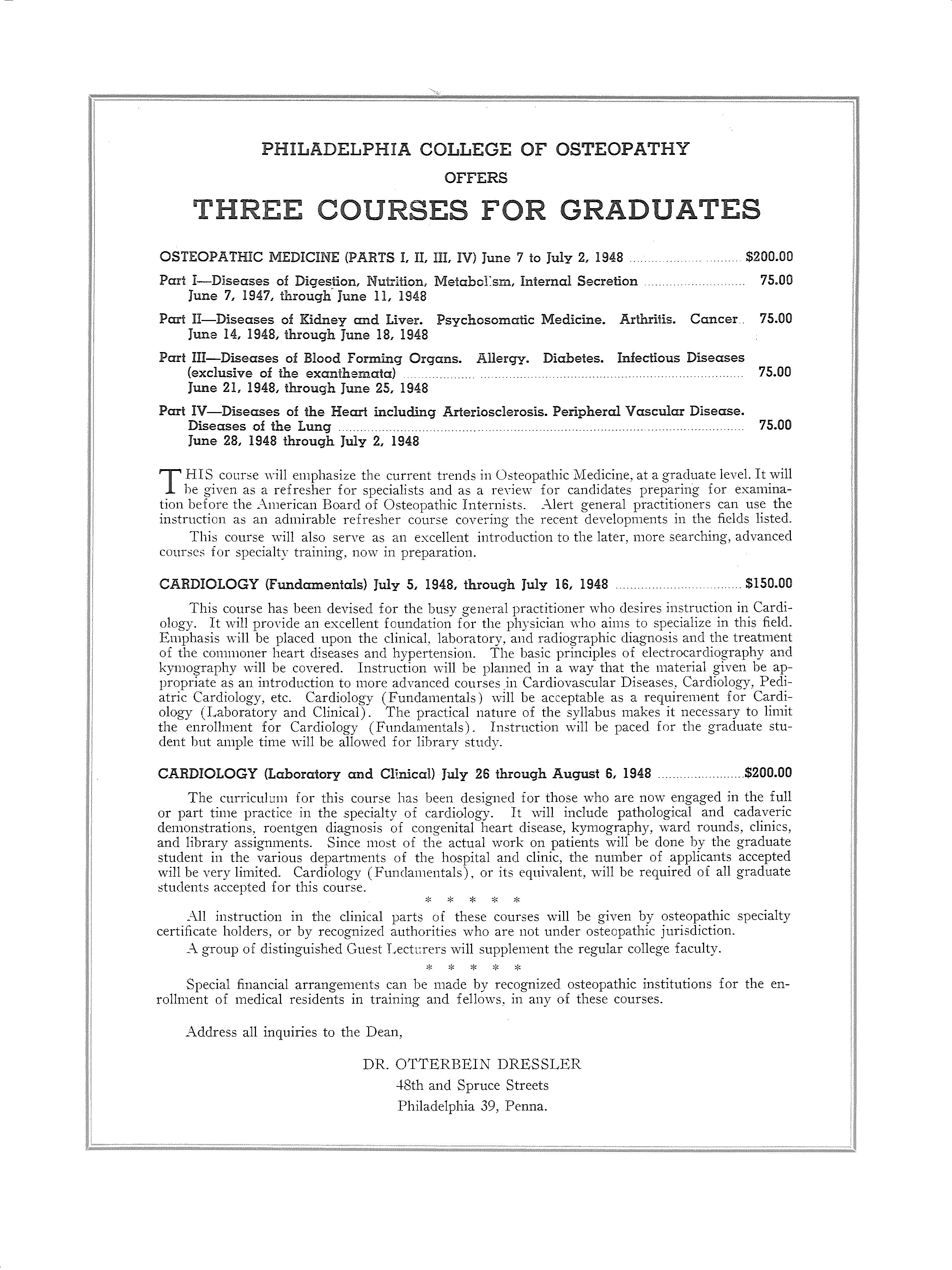
The curriculum for this course has been designed for those who are now engaged in the full : or part time practice in the specialty of cardiology. It will include pathological and cadaveric demonstrations, roentgen diagnosis of congenital heart disease, kymography, ward rounds, clinics, · and library assignments. Since most of the actual work on patients will be clone by the graduate student in the various departments of the hospital and clinic, the number of applicants accepted will be very limited. Cardiology (Fundamentals), or its equivalent, will be required of all graduate students accepted for this course.
* * * -;.. *
instruction in the clinical parts of these courses will be given by osteopathic specialty certificate holclers, or by recognized authorities who are not under osteopathic jurisdiction. A group of distinguished Guest will supplement the regular college faculty.
Special financial arrangements can be made by recognized osteopathic institutions for the enrollment of medical residents in training and fellows, in any of these courses. Address all inquiries to the Dean,
DR. OTTERBEIN DRESSLER
-1-8th and Spruce Streets Philadelphia 39, Penna.
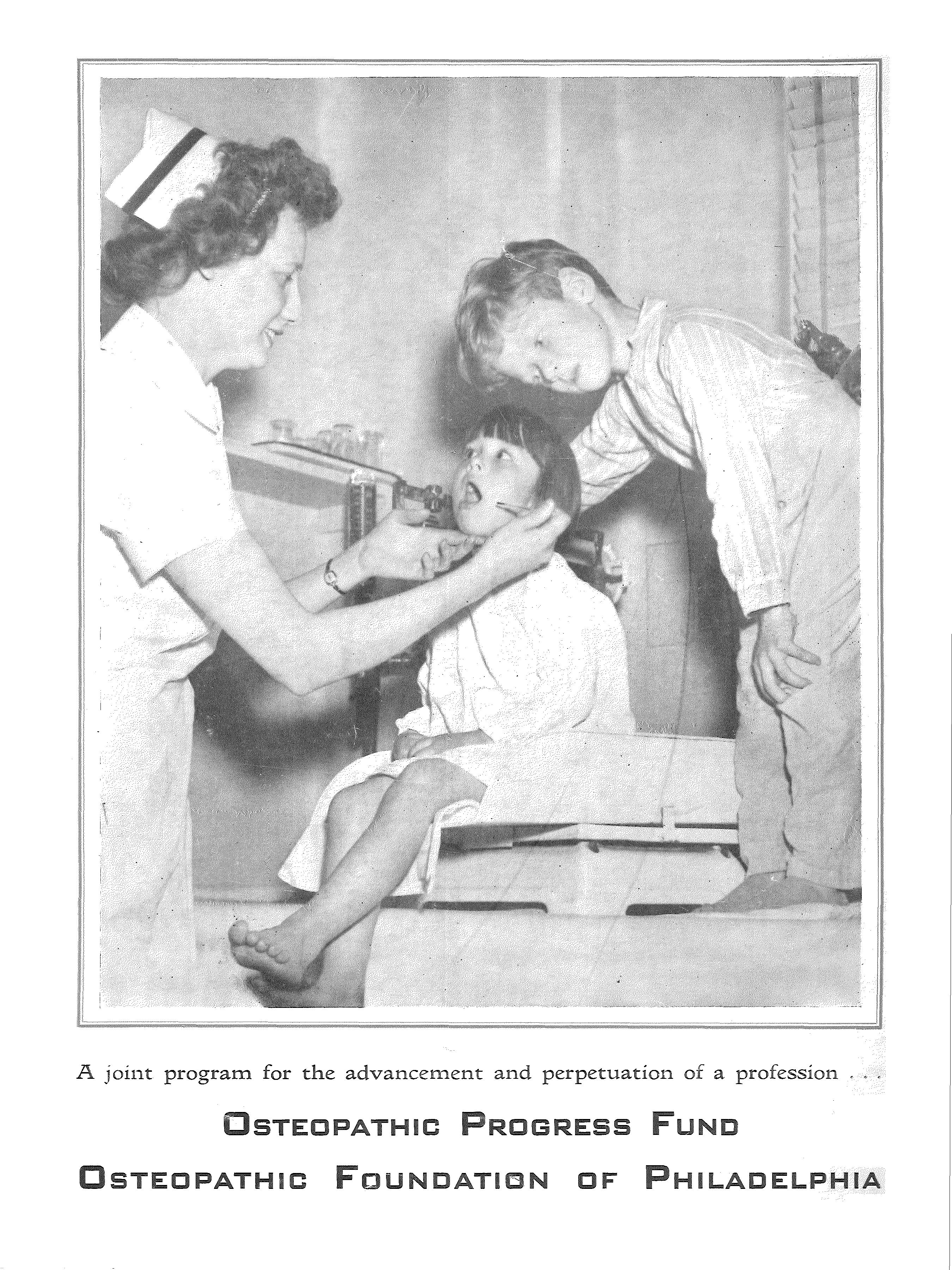
A joint program for the advancement and perpetuation of a profession OsTEOPATHIC P GRESS FUND